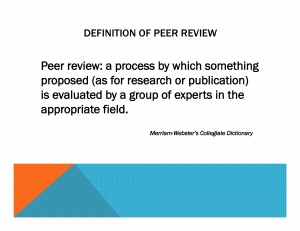Although the last two (2) posts mentioned things pertaining to reviewers and editing, they primarily dealt with the writing process. Here I will focus more explicitly on the peer review and editing process. Let’s get started.
The publication process model presented by Anita Ezzo consisted of nine (9) phases:
- Manuscript submission
- Acknowledgment of receipt
- Peer review
- Acceptance/rejection decision
- Manuscript formatting/editing
- Revisions approved/changes made by author
- Final editing and submission to journal
- Review of page proofs
- Publication
Each phase is equally important! Ignoring any one of them will present you from accomplishing your goal, publishing. Highlighted below are things I thought were significant in each step.
Manuscript Submission
- Choose a journal that you envision your work being included in. Do not limit your search to information science related journals
- Follow submission guidelines. Neglecting to do so will give editors the impression that you are careless and may delay the publication of your work
Acknowledgment of receipt
After sending your document, keep an eye out for a letter indicating the receipt of your paper. Be sure to read through that letter. Some journals use that opportunity to let you know whether your manuscript has been rejected or accepted for review. To avoid getting rejected early on refer to suggestion provided under “manuscript submission.”

Peer review
After the actual writing process, the peer review phase probably takes the most amount of time. For you that means waiting patiently. Typically your manuscript received, it is sent to several reviewers. Each reviewer reads through it and provides feedback. The purposes this step serves includes, helping strengthen your writing & ensuring its credibility. The thing reviewers are looking for while reading include,
- A topic of interest to readers
- Originality
- A clearly defined topic, purpose, significance of the study/research
- A literature review citing relevant studies in a logical progression
- Appropriate choice of research methods and procedures
- Research results that clearly presented/explained
- Logical/ justifiable conclusions
To insure your document includes all of these elements, it may be helpful to read through it with this list in hand. The weight each of these items hold varies from journal to journal. For example, whereas some journals may look for a comprehensive literature review, other journals are fine with a more general one. Reading through a few articles in a publication venue will help you figure out how the different sections should be proportioned.
Acceptance/rejection decision
Finally, after weeks (sometimes months of waiting), you find out whether your manuscript has been accepted or rejected. The decision is usually articulated using the following scale: “Accepted”; “Accepted, pending revisions”; “Rejected, but invite resubmission”; “Rejected.” The decision will usually be accompanied with feedback from the anonymous reviewer(s). The feedback can sometimes appear harsh, so prepare yourself. As I mentioned towards the end of part 2, seriously consider the feedback. If you feel it will strengthen your paper apply them, if not look for a new publication venue.
Editing & Revisions
If you fall under, “Accepted”, “Accepted, pending revisions” or “Reject, but invite resubmission”, you are in pretty good shape. But don’t become complacent, many people do. Be sure to consider and apply all of the suggestions made by the reviewers. Check your paper of issues pertaining to
- Grammar, spelling, punctuation,
- Data/statistical/citation errors &
- Table/Figure/text formatting
After amending the document put it down for a few days. Revisit it with fresh eyes. Give it one last review and submit it back to the journal for approval.
Finishing Touch
The finish line is within reach! After getting approval from the editor, you will sign a copyright agreement. Sometimes the agreement prevents the author from distributing the work to students in a class, posting it on their website, etc. To avoid a breach in contact and other complications, be sure you understand the terms of this agreement.
Once you’ve signed over the rights, you can sigh in excitement and relief. The editor of the publication, will do the rest of the work.
That’s All Folks
This three-part series highlights key points from the session entitled, “So They Said You Need to Publish.” It is likely that I capture only parts of the relevant messages that were conveyed. However, I am confident that the three parts provide you with more than enough to get you on your way.
If you publish a paper after reading through the series, let me know. If you have questions or things to add, use the comments section below.
